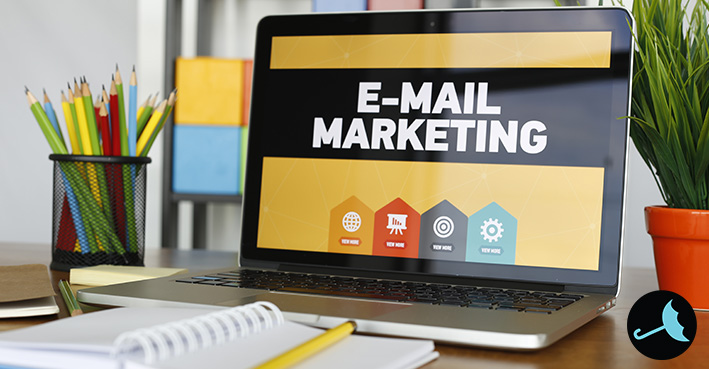How to Manage Email Marketing Lists and Campaigns | Local Service Marketing

Customer emails are a gold mine. The emails you’ve collected over the years are the most qualified prospect list you have. Take advantage! These are already people that have voluntarily signed up to receive emails from you. These are not cold calls. The people on your email list are already interested in what you have to offer. This is the backbone of email marketing.
We recommend sending out an email newsletter once a month. If you have something extra to say, you can send emails more frequently, but start with the goal of one per month.
If you don’t have a customer email list, or it’s pretty small, you can start gathering prospective emails from a downloadable checklist or another piece of useful information. Every month you send them a new piece of useful information, and you start to build a trustworthy relationship with them. Perhaps a year later, something breaks down and they need to call an expert. Since you are top of mind and a trusted resource, they’ll turn to you.
At VitalStorm, we’ve used email marketing for years to grow businesses and sell local services. Our clients who have made the effort to collect and store customer emails see a lot of success with email marketing. With welcome email sequences, targeted emails, lead magnets, and other email integrations, you can increase the bottom line and sell more services for a very low cost.
And with detailed analytics, it’s easy to understand how email leads to more revenue for your business. If you’re not sending regular emails to your customers, what are you waiting for?
Let’s start! Here are some actionable tips to get started with email marketing lists and campaigns.
Choose the Right Email Service
Here are five of the most popular email platforms, sometimes known as customer relationship management systems (CRMs).
| Free Version | Paid Plans | |
| Mailchimp | Up to 2,000 subscribers
Up to 10,000 emails/month |
$20/month
1,001-1,500 subscribers |
| AWeber | Free 30-day trial | $19/month
500 subscribers |
| Constant Contact | Free 60-day trial | $19/month
500 subscribers |
| GetResponse | Free 30-day trial | $15/month
1000 subscribers |
| Keap (formerly Infusionsoft) | Free 14-day trial | $199/month
2,500 subscribers |
- MailChimp – This is many people’s personal favorite since you can use it for free if you have less than 2,000 subscribers, making it great for newcomers wanting to get their feet wet. More advanced features are available for their paid plans.
- AWeber – AWeber is pretty similar to MailChimp. It’s really easy to use and comes with a free 30-day trial — no free plan though.
- Constant Contact – Constant Contact has a reputation for great customer service and a long free trial period. It’s easy to use their auto responders and templates, and they have pretty good analytics and features as well.
- GetResponse – GetResponse differentiates themselves from crowd by allowing you to create top-converting landing pages. They make it easy to build out landing pages that match your branding.
- Keap (formerly Infusionsoft) – Keap offers multiple paid plans, but their top-tier product is the most robust email and marketing automation platform we’ve seen. It’s much more than email software—it’s an entire customer relationship management system (CRM), but the extra features are reflected in the price. Test out their free trial to see if it’s right for you. There’s a pretty big learning curve, so you may need the help of a specialist. It’s definitely not your beginner email marketing platform. We recommend it for those who want a really efficient and robust CRM system.
These are some of the email marketing platforms we recommend, in order of complexity. Deeply familiarize yourself with an email marketing platform before choosing one. Sign up for their free trials first and see which one you like best.
Keep in mind that the email marketing software you choose will depend on a variety of factors, such as budget, size of email list, features, and functionality.
Email Features to Consider
Sign-up forms
We’ve all seen these pop-ups and sidebars asking for your email information in exchange for something of value. Many times, this is a free piece of content, but it could also be a discount, free consultation, or something else.
You want to make sure there is a sign-up form on your website, hopefully combined with some kind of free offer (aka “lead magnet”). The sign-up should trigger a welcome email series that starts building a trustworthy relationship with your customers.
Make sure you tell users what they will receive for signing up for emails.
Segmentation
Your email list should be segmented based on your audience. For instance, you’ll want to divide up your email list into current customers (recently purchased something from you), past customers (people who have purchased something a long time ago), and prospects (people who haven’t yet purchased anything from you). This is incredibly important. It allows you to segment your email responses by behaviors and demographics so you can target your messaging with relevant “drip campaign.”
A/B testing
A/B testing allows you to analyze your messaging by sending out two different emails to see which one performs better. This is great for learning what your audience responds to best.
Welcome email sequence
Welcome emails get sent to a user’s inbox after they have subscribed to receive your emails. These are the most important emails you will send since they set the bar for the rest of your emails. If you have a high opt-out rate with your welcome sequence, it may be time to write a new one. Make sure the email service you sign up for offers the ability to write and send a welcome email series.
Third-party integrations
Salesforce, Zendesk, and Google Drive are some of the ways you can integrate your email marketing efforts. Third-party integrations are critical if you are an eCommerce business. Make sure you test out the different integrations to make sure the email software works with your business.
Third-party integrations allow you to send targeted emails based on customer actions. For instance, eCommerce sites can send targeted emails to consumers who left times in your cart. Think about how many emails you’ve received from Amazon about your orders. That’s all third-party email software integrations.
Why Lead Magnets Are So Important
How do you attract strangers into your subscriber list in the first place?
Usually, it involves a lead magnet, which is a free piece of content in exchange for information, usually a name and email.
Here are some examples of lead magnets you can offer in exchange for email subscribers:
- eBook
- Infographic
- Checklist
- PDF report
- Webinar
- Audio
- Video
- Consultation
- Entry-level service/product
- Callback
- Course
- Giveaway
Pick the one thing that your customer would most likely want. What do they need, want, and desire?
If you don’t know, you can always test different lead magnets to see which one is the most popular.
What is the most popular service you offer? What pages on your website are most popular? Which social media posts are most popular?
Learn more about growing your email list with irresistible lead magnets.
Once a lead signs up, their information automatically gets added to your email marketing list. You can set it up so these sign-ups get segmented into their own list.
What Is a Drip Campaign?
A drip campaign is simply a series of emails that helps build trust and value for your company. your drip campaign should be focused on providing value for your subscribers. If people find your email valuable, they are much more likely to engage and call you when the time comes.
Here are the main stages of a drip campaign:
- First, turn strangers into friends via the email sign-up form (use a lead magnet as bait)
- Then, turn leads into sales via a welcome series drip campaign.
- Next, turn sales into repeat customers via different drip campaign.
- Finally, turn repeat customers into loyal brand advocates via different drip campaign.
There are other types of drip campaigns, but basically you want to have three separate drip campaigns for your customers depending on where they are in the buyer’s journey.
Email Marketing Terms and Rules
Permissions
One of the advantages of using an email software service is the ability for users to opt in or opt out of your emails. By confirming permission, you are less likely to have your emails reported as spam and more likely to have your subscribers open and engage with your emails. In order to remain compliant with the law, you are required to provide a clear way for people to opt out of your emails.
- Opt-in is when you enter your email address to subscribe to an email.
- Double-opt in is a confirmation email that makes people click on the double opt-in link from the email that is sent.
- Opt-out is when you choose not to receive emails from the sender anymore. It is legally required to include an opt-out link on every marketing email you send.
Spam
Permissions also help you avoid accusations of spam — unsolicited bulk emails that are considered junk mail.
There are actually regulations in place that help protect consumers from receiving unsolicited emails. The CAN-SPAM Act of 2003, which stands for Controlling the Assault of Non-Solicited Pornography and Marketing, is a set of laws that covers all commercial messages. The penalties for violating the CAN-SPAM Act are very costly, so it’s worth reviewing the main requirements found on the Federal Trade Commission website. According to the FTC, “each separate email in violation of the CAN-SPAM Act is subject to penalties of up to $42,530.”
Additionally, if you are in Canada or send emails to Canadian residents, you must comply with Canadian Anti-Spam Legislation (CASL), which has an even stricter set of rules and regulations. While email software providers like MailChimp make it easy to comply with all spam-related laws, it’s important to make sure you are compliant to avoid high penalties.
Bounce Rate
Bounce rate tells you how many emails were not delivered. Emails can bounce for a variety of reasons, but it’s important to pay attention to as you begin sending emails out to your subscribers. This is important to pay close attention to
Open Rate
The open rate is the percentage of emails that are opened. This tells you how many people are opening your emails.
How to Improve Your Email Marketing
The average person receives over 100 emails a day. How do you stand out?
People don’t hate emails, they just hate emails they don’t like. If you can provide value and/or entertainment, your customers will actually look forward to your emails. Done right, it’s a great way to build stronger relationships with your customers.
What kind of content should you be sending?
Add value! That’s the most important. You don’t want to be selling with every email.
Think about what adds value to your customers’ lives. Do they look for you for information? Deals? Entertainment?
Step into the shoes of your customer. What would you want?
Import Email Contacts
Email service providers make it easy to import your email lists into the system from a CSV or text file. This way, you can import all of the necessary customer information you’ve collected, such as names and emails.
Contact VitalStorm for a FREE Consultation
Don’t have time to run email marketing and drip campaigns on your own? Contact the experienced email marketing team at VitalStorm for your free consultation.
1-877-311-5695
Follow us on Facebook, Instagram, and Twitter for all the latest digital marketing news, tips and tricks.


